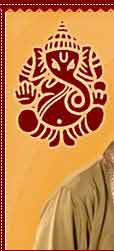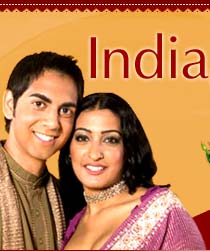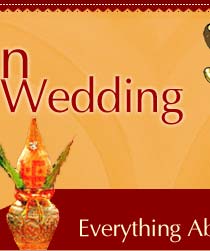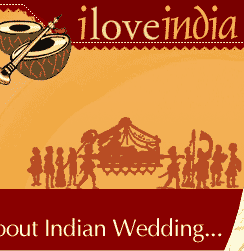|
|
|
|
According to Manusmriti or laws of Manu there are eight different types of Hindu marriages. They were as follows:
- Brahma marriage
- Daiva Marriage
- Arsha Marriage
- Prajapatya Marriage
- Gandharva Marriage
- Asura Marriage
- Rakshasa Marriage
- Paishacha Marriage
According to the historians these eight different types of marriages prevailed
in ancient India. Among the eight types all didn't have religious sanction.
The last four were not religiously defined it were condemned.
In Brahma marriage once the boy completes his Brahmacharya (studenthood), he is eligible to get married. His parents then approaches the parents or guardian of a girl belonging to a good family and ask them for the hand of their daughter for their son. The father of the girl also carefully chooses the bridegroom who is well versed in Vedas and of a noble character. This is how a Brahma marriage was arranged. There was no system of dowry. So the girl's family didn't have to give any dowry to the boy's family. There was the ritual of kanyadaan where the father uses to gift his daughter to the boy. In this system of marriage no commercial transaction is done. Among the eight types this is regarded as the highest type of marriage by the dharmasastras.
In case of Daiva marriage the girl is married to a priest (rtvik) during a sacrifice. In this type of marriage the girl's family wait for a reasonable period for a suitable man for their daughter but when nobody turns up they go looking for a groom in such places where a sacrifice is being conducted. Here the girl is groomed with ornaments and married to a priest. According to the sastras Daiva marriage is considered inferior to Brahma marriage because it is considered degrading for the womanhood to look for groom. It is only the groom's family that will seek bride for their son than only womanhood is elevated.
The third type is Arsha marriage that suggests marriages with the sages or rishis. References from dharmasastras tells us that in arsa the bride is given in exchange for two cows received from the groom. Marriages of this type used to happen because the parents of the bride couldn't afford the expense of their daughter's marriage at the right time according to the brahma rite. So the girl is married off to an old sage. The cows, which were taken in exchange of the bride shows that even the groom does not have any remarkable qualities. According to sastras noble marriages had no monetary or business transactions so this kind of marriages were not considered noble.
Monetary transactions and Kanyadaan is not a part of Prajapatya marriage unlike the Brahma marriage where these two forms an important and basic part. Unlike the Brahma type here the bride's father goes in search for a groom for his daughter. The Brahma type is considered a better type of marriage than prajapatya because in Brahma type the groom's family goes out to seek a suitable bride for their son.
Next is Gandharva marriage, which is more like love marriage. Here the bride and the bridegroom get married secretly without the knowledge of their parents. This kind of marriage is similar to the love marriages of today's generation. It is not considered a right kind of marriage as it is done against the will of the parents so it is inferior kind of marriage. This marriage reminds us of the love affair of Sakuntala and Dusyanta.
In the Asura type of marriage the groom is not at all suitable for the bride. In no way he is a match for the girl but the bridegroom willingly gives as much wealth as he can afford to the bride's parents and relatives. So the system of marriage is more like buying a product. In Arsha type cows are given in exchange for the bride but there is no compulsion like the Asura type. Even the groom is also not so rich and powerful like his counterpart in Asura type.
Rakshasa marriage is a type, in which the groom fights battles with the bride's family, overcomes them and carries her away and then persuades her to marry. This is not considered as the right kind of marriage as you are forcing somebody to marry.
Paishacha marriage is the eighth and last type of marriage. It is considered as the most inferior type of marriage. In this type the girl's wish is not considered whether she wants to marry or not instead she was force to marry and even the bride's family is also not given anything in cash or kind. She is seized against her wish. And the marrige is done against the wish of the girl and her family. Men would marry a woman, whom he had seduced while she was asleep, intoxicated or insane. This kind of marriage was later prohibited.
So looking at all the eight types of marriages it can be said that we have two extreme at two ends. It is true that there cannot be same and uniform rule for everybody. The Hindu sastras has divided each type according to the social structure and system. So it is the people living in the society who can decide, which one to opt and it is wrong on our part to advocate the same system for all.
In Brahma marriage once the boy completes his Brahmacharya (studenthood), he is eligible to get married. His parents then approaches the parents or guardian of a girl belonging to a good family and ask them for the hand of their daughter for their son. The father of the girl also carefully chooses the bridegroom who is well versed in Vedas and of a noble character. This is how a Brahma marriage was arranged. There was no system of dowry. So the girl's family didn't have to give any dowry to the boy's family. There was the ritual of kanyadaan where the father uses to gift his daughter to the boy. In this system of marriage no commercial transaction is done. Among the eight types this is regarded as the highest type of marriage by the dharmasastras.
In case of Daiva marriage the girl is married to a priest (rtvik) during a sacrifice. In this type of marriage the girl's family wait for a reasonable period for a suitable man for their daughter but when nobody turns up they go looking for a groom in such places where a sacrifice is being conducted. Here the girl is groomed with ornaments and married to a priest. According to the sastras Daiva marriage is considered inferior to Brahma marriage because it is considered degrading for the womanhood to look for groom. It is only the groom's family that will seek bride for their son than only womanhood is elevated.
The third type is Arsha marriage that suggests marriages with the sages or rishis. References from dharmasastras tells us that in arsa the bride is given in exchange for two cows received from the groom. Marriages of this type used to happen because the parents of the bride couldn't afford the expense of their daughter's marriage at the right time according to the brahma rite. So the girl is married off to an old sage. The cows, which were taken in exchange of the bride shows that even the groom does not have any remarkable qualities. According to sastras noble marriages had no monetary or business transactions so this kind of marriages were not considered noble.
Monetary transactions and Kanyadaan is not a part of Prajapatya marriage unlike the Brahma marriage where these two forms an important and basic part. Unlike the Brahma type here the bride's father goes in search for a groom for his daughter. The Brahma type is considered a better type of marriage than prajapatya because in Brahma type the groom's family goes out to seek a suitable bride for their son.
Next is Gandharva marriage, which is more like love marriage. Here the bride and the bridegroom get married secretly without the knowledge of their parents. This kind of marriage is similar to the love marriages of today's generation. It is not considered a right kind of marriage as it is done against the will of the parents so it is inferior kind of marriage. This marriage reminds us of the love affair of Sakuntala and Dusyanta.
In the Asura type of marriage the groom is not at all suitable for the bride. In no way he is a match for the girl but the bridegroom willingly gives as much wealth as he can afford to the bride's parents and relatives. So the system of marriage is more like buying a product. In Arsha type cows are given in exchange for the bride but there is no compulsion like the Asura type. Even the groom is also not so rich and powerful like his counterpart in Asura type.
Rakshasa marriage is a type, in which the groom fights battles with the bride's family, overcomes them and carries her away and then persuades her to marry. This is not considered as the right kind of marriage as you are forcing somebody to marry.
Paishacha marriage is the eighth and last type of marriage. It is considered as the most inferior type of marriage. In this type the girl's wish is not considered whether she wants to marry or not instead she was force to marry and even the bride's family is also not given anything in cash or kind. She is seized against her wish. And the marrige is done against the wish of the girl and her family. Men would marry a woman, whom he had seduced while she was asleep, intoxicated or insane. This kind of marriage was later prohibited.
So looking at all the eight types of marriages it can be said that we have two extreme at two ends. It is true that there cannot be same and uniform rule for everybody. The Hindu sastras has divided each type according to the social structure and system. So it is the people living in the society who can decide, which one to opt and it is wrong on our part to advocate the same system for all.



